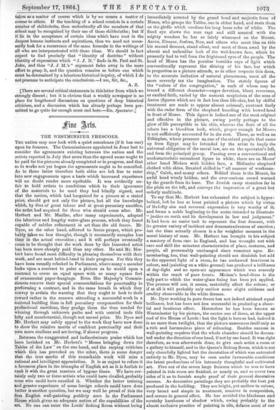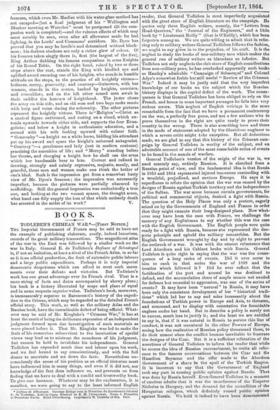lint arts.
TILE WESTMINSTER, FRESCOES.
THE nation may now look with a quiet conscience (if it has one) upon its frescoes. The Commissioners appointed in June last to consider the agreements existing between the nation and the artists reported in July that.more than the agreed sums ought to be paid for the pictures already completed or in progress, and that as to works not yet begun the agreements ought to be cancelled. As to these latter therefore both sides are left free to enter into new engagements upon a basis which increased experience will no doubt render more equitable. It was evidently un- fair to hold artists to conditions which in their ignorance of the materials to be used they had blindly signed, and that the nation, which had bargained for a picture at a stated price, should get not only the picture, but all the knowledge which, by dint of great labour and at great pecuniary sacrifice, the artist had acquired for those who should come after. Mr. Herbert and Mr. Maclse, after many experiments, adopted the laborious and lengthy water-glass process, which they found capable of subtler refinement in art than the old fresco. Mr. Dyce, on the other hand, adhered to fresco proper, which pro- bably takes no less thought, though it necessarily occupies less time in the actual execution ; and it will perhaps eventually come to be thought that the work done by this lamented artist has been more cheaply paid than any other. He and Mr. Her- bert have found most difficulty in pleasing themselves with their work, and are most behind-hand in their progress. For this they have been roundly rebuked in Parliament, where many a member looks upon a contract to paint a picture as he would upon a contract to cover an equal space with so many square feet of ornamental paper-hangings. Even Her Majesty's Commis- sioners reserve their special commendations for punctuality in performing a contract, and in the same breath in which they convey to artists the warning that they ought to look to their reward rather in the renown attending a successful work in a national building than in full pecuniary compensation for their professional sacrifices, they grudge them the time needed for winning through unknown paths and with untried tools this lofty, and unsubstantial, though not unreal prize. Mr. Dyes and Mr. Herbert may safely appeal to the work they have now done to show the relative merits of confident punctuality and their own more studious and art-loving, if slower progress.
Between the exaggerated and indiscriminate praise which has been lavished on Mr. Herbert's " Moses bringing down the Tables of the Law " on the one hand, and the carping criticism which this has provoked on the other, there is some danger that the true merits of this remarkable work will miss a rational and intelligent appreciation. It is as unjust to refuse it a foremost place in the triumphs of English art as it is foolish to rank it with the great masters of bygone times. We have cer- tainly only two or three artists who could have rivalled, probably none who could have excelled it. Whether the better training and greater experience of some foreign schools could have done better is another question, but we may well be proud of this the first English wall-painting publicly seen in the Parliament House which gives an adequate notion of the capabilities of the art. No one can enter the Lords' Robing Room without being
immediately arrested by the grand head and majestic form of Moses, who grasps the Tables, one in either hand, and rests them on the girdle which confines his long loose robe of white. The fixed eye shows the man rapt and still amazed with the mighty wonders he has so lately witnessed on the Mount. Aaron, Eleazar, Joshua, Nun, and others who meet him on this his second descent, stand silent, and most of them awed by the absent and unfamiliar look of the well-known face, which he presently had to veil from the frightened eyes of the people. The bead of Moses has the peculiar hornlike rays of light which conventionally represent the shining of his face, but which in proportion as a picture attends, as in other respects this does, to the accurate imitation of natural phenomena, must all the more severely tax the imagination. The stately figures of the "rulers of the congregation," in each of whom may be traced a different character—eager devotion, blunt reverence, or exalted faith, varied by the nascent scepticism of the sons of Aaron (figures which are in. fact less than life-size, but by skilful treatment are made to appear almost colossal), contrast finely with the ruder form of the shepherd kneeling with bowed head in front of Moses. This figure is indeed one of the most original and effective in the picture, owing partly perhaps to the glow of life perceptible in his skin, whereas the flesh of all the others has a bloodless look, which, proper enough for Moses, is not sufficiently accounted for in the rest. These, as well as an Ethiopian, whose presence as one of the mixed people that came up from Egypt may be intended by the artist to imply the universal obligation of the moral law, are on the spectator's left, and form the principal group. Passing over a conventional and uncharacteristic recumbent figure in white, there are on Moses' other hand Miriam with bidden face, a Midianite shepherd clothed with skins, Bezaleel skilled in " all manner of workman- ship," Caleb, and many others. Behind these is the Mount, its awful head wisely hidden, and the over-curious crowd warned by the guards from its base. The Jewish camp stretches far in the plain on the left, and conveys the impression of a great but orderly multitude.
To say that Mr. Herbert has exhausted the subject is hyper- bolical, but he has at least painted a picture which by virtue of its lofty aim and reverent expression is very worthy of it, and forms a noble beginning to the series intended to illustrate " justice on earth and its development in law and judgment." It had been an easier task to represent the first descent, with its greater variety of incident and demonstrativeness of emotion ; but the time actually chosen is a far weightier moment in the moral history of man. Mr. Herbert has brought to his subject a mastery of form rare iu England, and has wrought out with care and skill the minutest characteristics of place, costume, and people, all presumably unchanged since remotest ages. Re- membering, too, that wall-painting should not diminish but add to the apparent light of a room, he has eschewed heaviness in colour, and (painting on a white ground) has produced a brilliance of day-light and an open-air appearance which was scarcely within the reach of pure fresco. Miriam's head-dress is the only part to which the water-glass fixing has been yet applied. The process will not, it seems, materially affect the colour; or if at all it will probably only mellow some slight coldness and crudity observable in the white dresses.
Mr. Dyce working in pure fresco has not indeed attained equal brilliance, but has been not less successful in producing a cheer- ful and luminous effect. Heretofore he has been known at Westminster by his picture, the centre one of three, at the upper cud of the House of Lords : but the light is here so bad, indeed it is no more than twilight, that the picture announces itself only as a rich and harmonious piece of colouring. Besides success in wall-painting requires that the whole chamber should be decora- ted under the direction of one head, if not by one hand. It was right therefore, as was afterwards done, to give each artist a room or a gallery to himself, and in the Queen's Robing Room, which is not only cheerfully lighted but the decoration of which was entrusted entirely to Mr. Dyes, may be seen under favourable conditions the latest productions of his intensely thoughtful and cultivated art. Five out of the seven large frescoes which, he was to have painted in this room are finished, or nearly so, and so cover two sides of it as to furnish ample proof of their general decorative success. As decorative paintings they are probably the best yet produced in the building. They are bright, yet mellow in colour, very broad and simple in treatment, massive in composition, and serene in general effect. He has avoided time blackness and scratchy harshness of shadow which, owing probably to the almost exclusive practice of painting in oils, defaces most of our
frescoes, which even Mr. MacRae with his water-glass method has . not escaped—(but a final judgment of his " 'Wellington and Blucher meeting at 'Waterloo" must be postponed till the com- panion work is completed)—and the ruinous effects of which may most notably be seen, even after all allowance made for bad lighting, in the Lords' and Commons' corridors. Mr. Dyce has proved that you may be forcible and determined without black- ness ; his darkest shadows arc only a richer glow of colour. Of his frescoes taken singly there is, first (the largest of the five), King Arthur dubbing his famous companions in arms Knights of his Round Table. On the right hand, raised by two or three steps above the rest, stands the King with kindled eye and uplifted sword swearing one of his knights, who stands in humble attitude on the steps, to the practice of all knightly virtues— holiness, mercy, generosity, and courtesy—Guinevere, with her women, stands in the centre, backed by knights, courtiers, and councillors, and on the left other armed men await in their saddles the honours of knighthood. The jester closes the array on this side, and an old man and two boys make music with harp and voice during the solemnity. The other pictures represent the knightly virtues. There is "Religion"—Christ as a central figure enthroned, and resting on a cloud, which ex- tends upwards towards either side, and supports the four Evan- gelists; and below a knight in enthusiastic adoration, and a second with his wife looking upward with calmer faith. " Generosity "—a knight on a white horse, bidding his attendant put up his sword and spare the knight's unhorsed antagonist. " Courtesy"—a gentleman and lady (not in modern costume) practising the amenities of life; and "Mercy" standing before her throne, and charging a knight how he shall use the arms which her handmaids bear to him. Correct and refined in drawing, strongly and calmly expressive, majestic, manly, and graceful, these men and women make one think the better of one's kind. Such is the impression got from a somewhat hasty view of Mr. Dyce's frescoes ; the impression was necessarily imperfect, because the pictures were partially obscured by scaffolding. Still the general impression was undoubtedly a true one, and looking at the two vacant spaces, the thought arose, what hand can fitly supply the loss of that which untimely death
has arrested in the midst of its work ? V.































 Previous page
Previous page